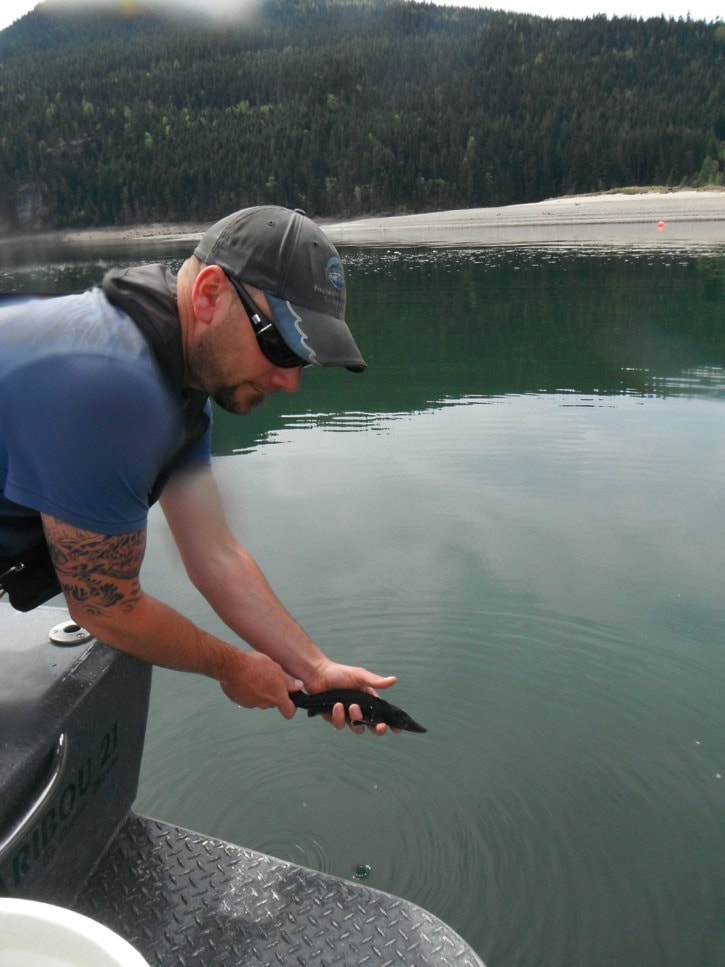Reports of dead kokanee surfacing in the Upper Arrow Lakes has prompted an investigation by government biologists, but so far no cause has been determined as to why the fish are dying.
Reports of dead kokanee surfacing in the Shelter Bay area started in mid-May and the last report came in on May 28. That has prompted an investigation by BC Hydro, the B.C. Ministry of Forests, Lands and Natural Resources Operation (FLNRO); and Fisheries & Oceans Canada.
“There were reports of young Kokanee, small ones between two and eight inches,” said BC Hydro spokesperson Jen Walker-Larsen. “They might result from a number of natural and man-made causes. We’re taking a look.”
So far, several potential causes were looked at. One reason – low-volume spills at the Revelstoke Dam – was discounted because the spilling began after the first reports of dead fish came in, Larsen said. There have also been no reports from between the Revelstoke Dam and the Shelter Bay ferry landing.
Investigators have also looked to see if there’s any connection between dead kokanee and the Fish & Wildlife Compensation Program’s Arrow Lakes Nutrient Restoration Program that operates from the Shelter Bay ferry.
“There’s no evidence of that,” said Larsen. “We have looked at a small sample of fish and it seems to be physical.”
Posters have been distributed to known reservoir users such as the Revelstoke Rod and Gun Club and posted at recreation sites in the Shelter Bay area notifying people of the issue.
“Kokanee fish kills are not uncommon and there haven’t been any new reports since May 28,” said Larsen.
The regional fish biologist for Ministry of FLNRO was on vacation and unable to return calls before press time.
Information coming in on sturgeon release
The first batch of data has come in from 50 juvenile white sturgeon that were released into the Columbia River in May.
The sturgeon are fitted with sonic tags that are being picked up by 29 receivers that are set up in a 29-kilometre-long stretch of the Columbia River near the Walter Hardman generation station at Cranberry Creek south of Revelstoke. The tags give off a ping every few minutes and that information is collected by the receivers and used to track the fish’s movement.
The area is a popular spot for juvenile sturgeon.
The first set of tracking data shows the young sturgeon are staying near the release site and are travelling less than 500 metres per day, said BC Hydro’s Jen Walker-Larsen. The fish tend to stay in the deepest part of the reservoir, which is about 6-9 metres deep.
“It will be interesting to see if their behavior changes and if they move out of the river channel as the water warms and the water level rises as Arrow Lakes Reservoir refills to summer levels,” she said.
The information is being collected to give BC Hydro an understanding of how white sturgeon use the Upper Arrow Lakes Reservoir. It is part of an on-going project to help restore white sturgeon population in the Columbia River.
This year BC Hydro released more than 10,000 juvenile sturgeon into the Columbia River at releases in Castlegar and at Shelter Bay. About 165,000 sturgeon have been released into the Columbia River between the Grand Coulee Dam in Washington and Revelstoke since 2001.
According to BC Hydro, about 50 adult sturgeon live in the Arrow Lakes Reservoir. Sturgeon can grow up to six metres long, weigh close to 700 kilograms and live for more than 100 years.
However, research has shown that few young fish are surviving to adulthood, Larsen added.
